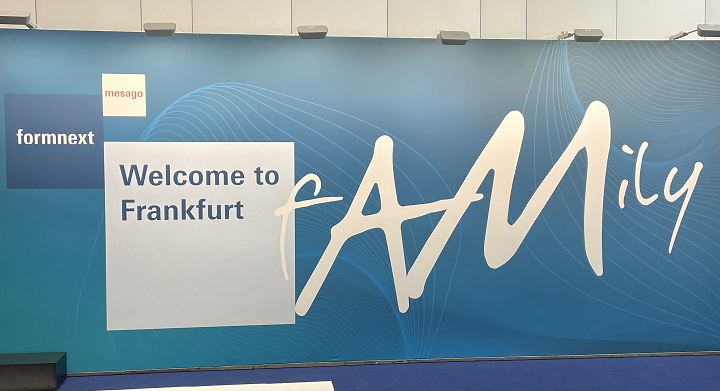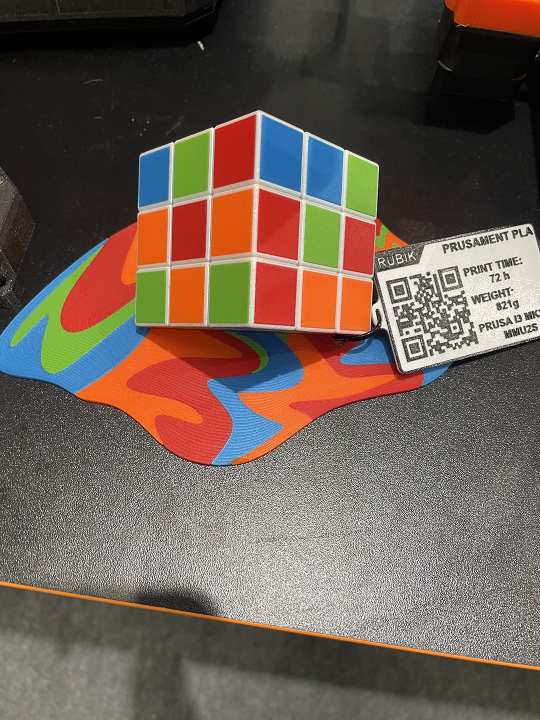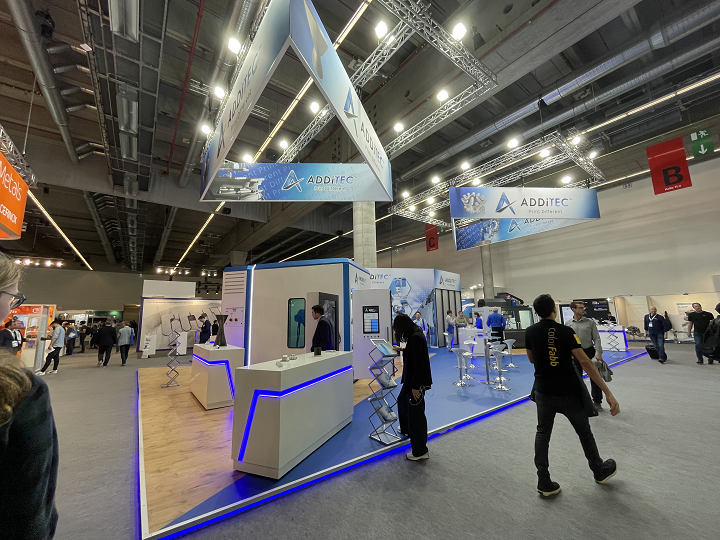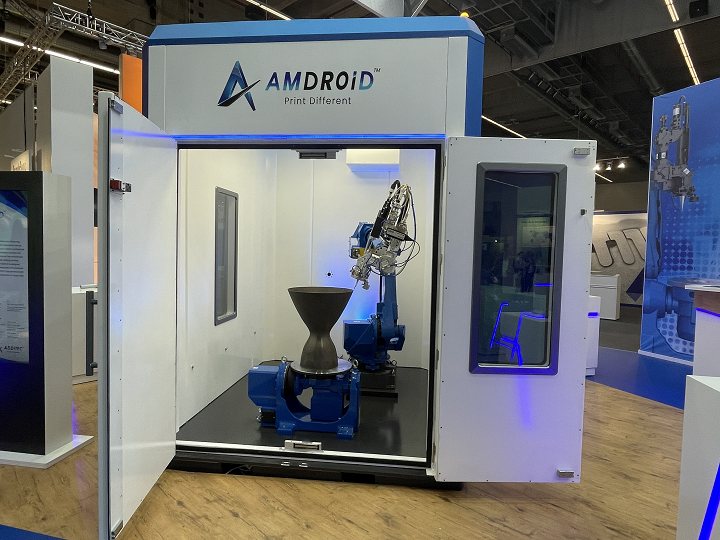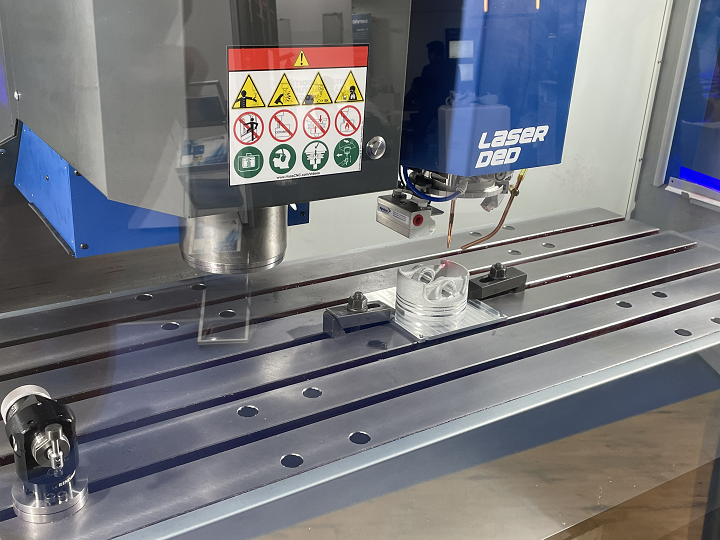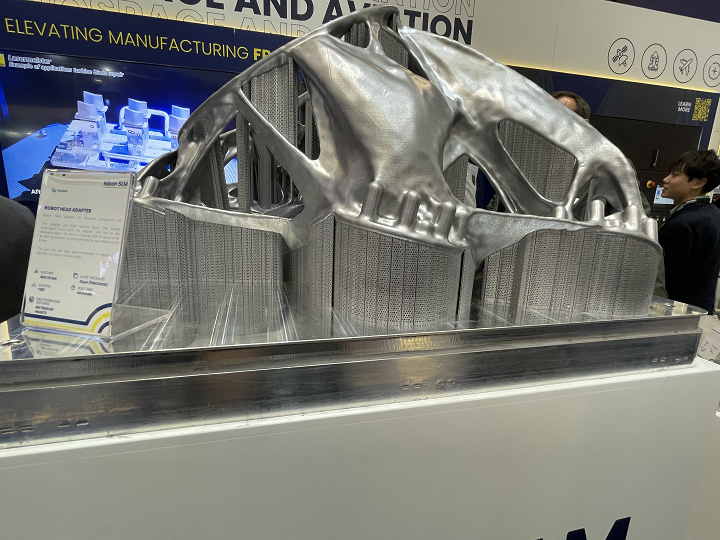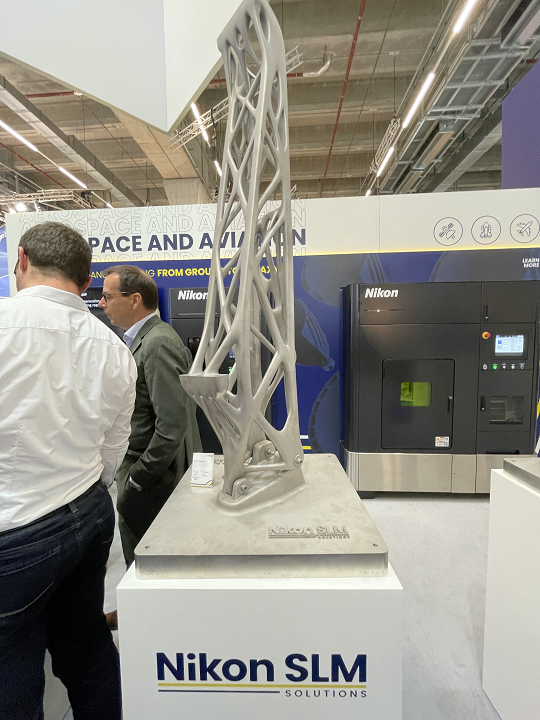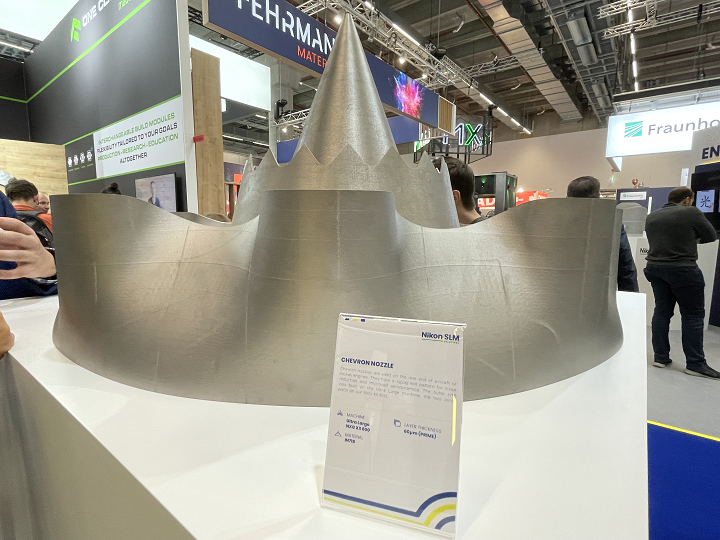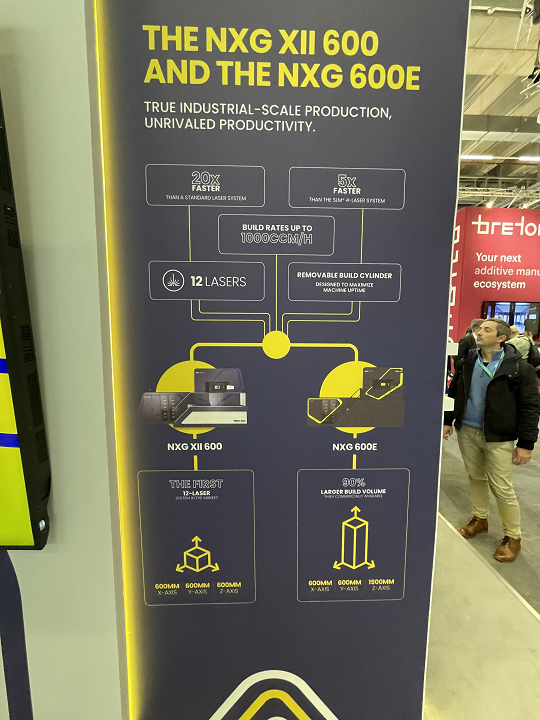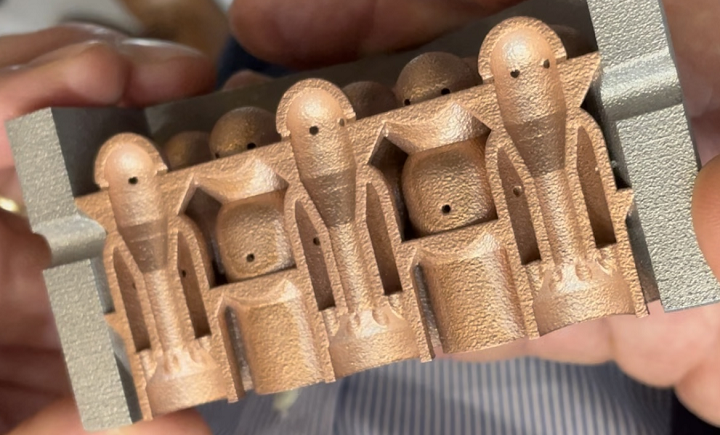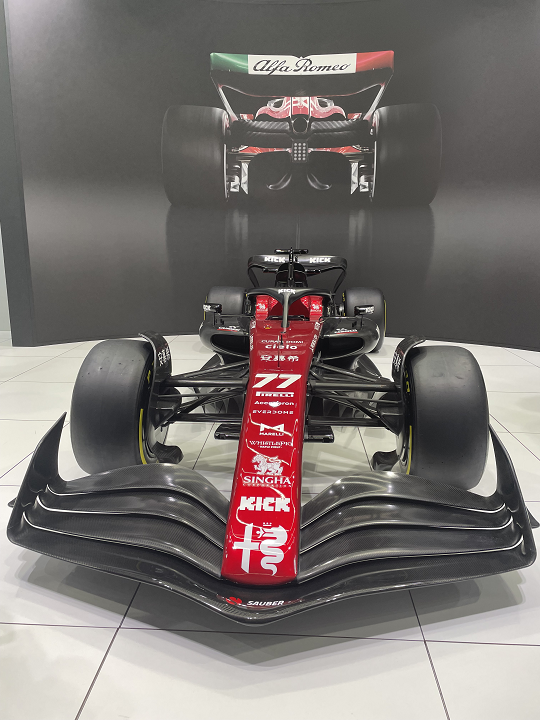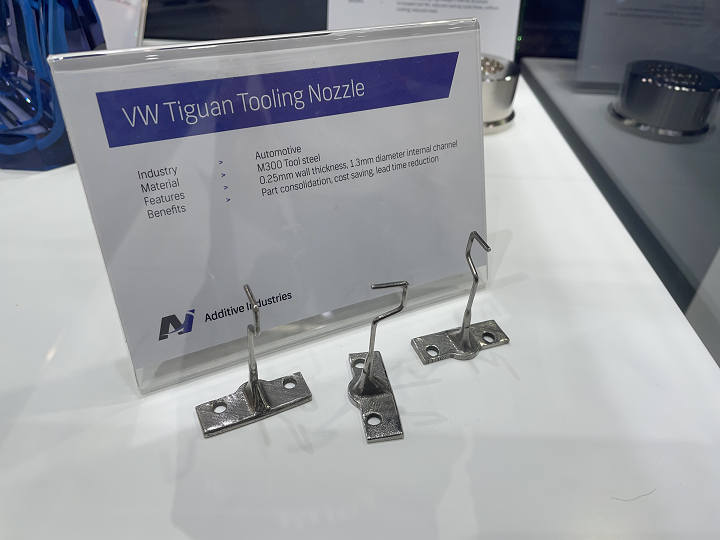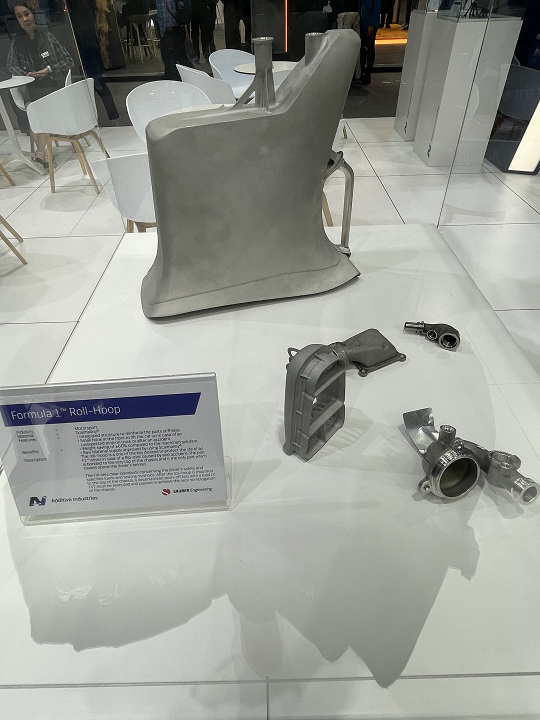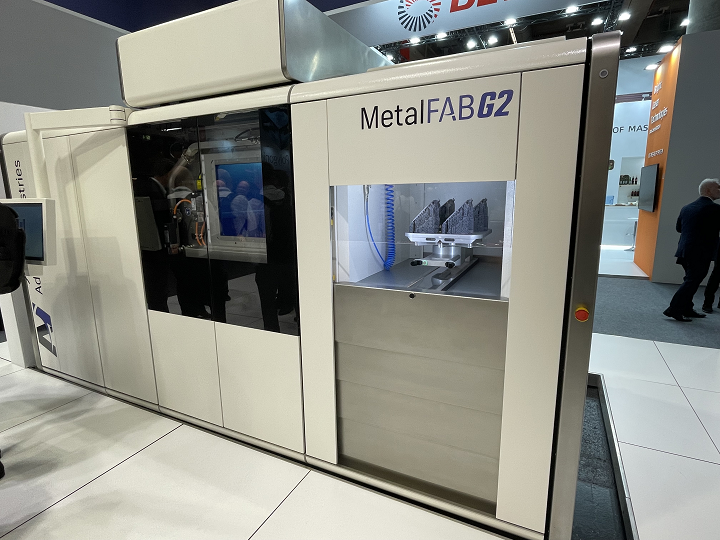Alongside other sectors of the additive manufacturing (AM) sector—such as materials, software, and post-processing—the metal 3D printing industry is in the process of a disruptive transformation, with technologies like directed energy deposition (DED) steadily on the rise, while powder bed fusion (PBF) becomes further integrated into industrial manufacturing. Among the firms demonstrating these changes are ADDiTEC, Nikon SLM Solutions, and Additive Industries. I had a chance to speak to representatives from all three businesses, as they showcased their latest wares and discussed the larger technological and business landscape.
ADDiTEC
ADDiTEC is a founding partner of directed energy deposition (DED) manufacturer MELTIO. It also acquired Elem Additive Solutions, Xerox’s metal AM subsidiary. Xerox had all but eliminated its 3D printing division only a year after its ElemX liquid metal printer was unveiled, and the acquisition by ADDiTEC resurrected the technology.
I spoke with Guy Morency, Sr. Engineer of Systems at ADDiTEC, who told me that the company has two basic additive technologies—laser DED (LDED) and Liquid Metal Jetting (LMJ)—in addition to CNC capabilities. We first looked at the AMDroid, a forward-deployable robot cell rated for reactive materials. Morency explained that it has a multi-axis robot, a 6 kW laser, and a wire feed.
“It focuses the laser on a particular area of the part. The part is slowly moving, heats up localized heat and feeds the wire feed into it, and of course it melts with the part and it just builds the part layer by layer.”
The AMDroid features closed loop process controls, and is able to print parts up to 1.8 meters, while also achieving intricate geometries. Materials that can be printed on this system include aluminum, copper, Inconel, titanium, and carbon steel, mild steel, and stainless steel.
Then, we went over to the Hybrid 3 multi-tech manufacturing system, which features LDED, LMJ, and CNC machining capabilities in one platform, and uses the same kind of laser as the AMDroid. At the time, it was in CNC mode and milling a part, but Morency showed me how easily the Hybrid can switch things up to the LMJ and LDED technologies.
“We’re able to build a part while it’s being printed, so you can print a part, scan it, look for imperfections that have occurred, and we can actually subtract material from the part.”
He simply selected the LMJ setting on the control panel, and the liquid metal jetting attachment in the machine quickly moved over and replaced the CNC head.
“We feed wire through a connection that happens in the back. There’s a high-powered, heated crucible inside, and so we’re melting that into liquid,” Morency explained. “We primarily deal with aluminum alloys. This melts the aluminum, and another part shields a high-current, high-voltage coil. When you pulse the molten crucible, it forces a drop of aluminum out the bottom.”
The Hybrid 3 can deposit about 400 drops a second, which are shielded in an argon gas, so no oxidization occurs. The combination of multiple manufacturing processes with LMJ is a significant advancement over Xerox’s original ElemX platform, which could only print parts. These components were typically limited in terms of shape, so the addition of CNC opens up the geometric complexity, and therefore immediate applications, of the technology. This was evidenced by the parts Morency showed, which included the different types of structures that can be printed on ADDiTEC’s machines, as well as colors, holes, and walls.
With an engine nozzle on the AMDroid, and the piston being printed on the Hybrid 3, it’s clear the systems can do work in aerospace and mechanical applications, but he said the variety was even greater.
“Whatever kind of parts you can imagine printing, whatever their application is, we can do it.”
Nikon SLM Solutions
In September of 2022, Japanese lithography, scanning and camera firm Nikon made a bid to acquire metal 3D printer manufacturer SLM Solutions for a whopping €622 million, or €20 per share. The deal closed in January of 2023, and the rebranded company debuted this fall, as Nikon SLM Solutions, with a high-profile sale of two NXG XII 600 systems to GKN Aerospace.
Chief Commercial Officer Charlie Grace showed me the large Inconel 718 print below, and said that at formnext 2022, the SLM booth displayed a similar one, which was printed in three parts and then assembled. The newest version, however, was printed in one full piece in seven days.
The company had also 3D printed an aircraft engine pylon in Inconel 718 on the 12-laser NXG XII 600E platform, which is “a variant of the NXG XII 600.”
“[The NXG XII] is 600 x 600 x 600 mm,” he told me about the predecessor’s build volume, “and [the NXG XII 600E] is the bigger brother, which prints 600 mm x 600 mm x 1.5 meters.”
Grace explained that, in addition to Inconel, the most typical alloys printed on the NXG systems are aluminum and titanium, and that the most “prevalent verticals” for the company’s massive printers are aerospace and defense, automotive, and energy.
“For space companies to be able to create an engine like that in one print is a big deal.”
Plus, the lead time for parts that size on the NXG systems is significantly decreased, going down from several months to only a week. Grace also reminded me of another important factor, which is that rocket companies can quickly build multiple iterations of a part.
“For rocket companies, it’s the size of the payload. Many rockets are getting bigger, which means more payload, so they need more engines. They also have to put things in the payload, and so you can print in titanium,” he explained.
We also looked at a chevron nozzle by ADIRA, whose AddCreative laser powder bed fusion (LPBF) technology the company acquired earlier this year in order to enhance its product lineup. ADIRA’s Tiled Laser Melting technique segments the total printing area into discrete tiles. Each tile is printed sequentially in a strategically optimized order within a dynamic build chamber. The design of the system enables the laser head to traverse on a gantry, which facilitates the independent functioning of the recoater. Such an arrangement potentially allows for the use of multiple lasers to concurrently print various components. This capability significantly enhances the machine’s efficiency and expands its ability to produce larger items more rapidly.
Grace gave me a great example of how well-suited the initial technologies of Nikon and SLM Solutions are to each other in this combined company: repair of turbine blade tips and shrouds. He explained that several of these parts in need of repair are placed in a jig inside of a Nikon scanner.
“Then, we do a full scan of the product, and we have software that compares the digital twin, if you will, to the actual product,” he said. “Then you put the jig into the printer and it’ll actually do the repair in the printer automatically. This employs a Nikon scanning solution, a printing solution, and software in between.”
He said that Nikon had definitely “brought some expertise to the party.” It sounds like a good marriage.
Nikon SLM Solutions also signed a memorandum of understanding with Fraunhofer IGCV (Research Institute for Casting, Composite and Processing Technology) at formnext to bring multimaterial metal AM to the market; the two have been collaborating on this for years. Some of the incredibly detailed parts displayed included an inductor and an e-stator for an electric motor printed out of steel and copper alloys, and a hydraulic plate printed out of an aluminum alloy.
Additive Industries
Kartik Rao, the Strategic Marketing Director at Additive Industries, a leading Dutch metal 3D printer manufacturer, recently emphasized the company’s growing focus on the automotive sector. This direction was showcased by the presence of a race car at the company’s formnext 2023 exhibit. Rao highlighted that Additive Industries has an impressive install base of 60 machines, which effectively amounts to about 100, due to the modular nature of its MetalFAB system. He noted that while about one-third of these machines are utilized in the space industry, there is a noticeable and increasing demand in the automotive sector, especially in racing applications.
“It’s been quite an important market for us over the past few years, and we’re keen on diversifying our portfolio of industries. Automotive is a ripe segment for us,” Rao said. “Automotive represents the pinnacle of volume production, far more so than aerospace. That’s where everyone wants to be now: volume production. I think that’s what drives them, that need for volume. They’re also looking for a good price point as well, and automated technology helps with this. It’s the only thing that really fits.”
The company worked with former partners Volkswagen and Alfa Romeo Sauber again this past year, and the latter operates four of Additive Industries’ fully automated systems, or a total of eight with the mods, printing 27,000-30,000 parts annually, most of which “end up in the car.”
“What’s appealing about our system in automotive is scalability and safety. First, they like the automation. They’re very familiar with it. What automation enables for us is scaling, because you don’t need to hire 20 people to work the system,” Rao explained. “For safety, in the U.S., lots of automotive facilities are unionized, and in Europe, they’re very stringent about the safety laws. With our systems, we keep powder completely away from the operators with automated depowdering. What the operator is presented with is a part free from powder. These are the two core selling points that make us attractive to automotive.”
Rao said the company’s focus going into 2024 is automotive and tooling, as it’s “a rich scene now.” He showed me a small 3D printed tooling nozzle, used to secure the window frames of mid-sized Volkswagen SUVs. The window is glued to the frame, and this hollow nozzle deposits a thin line of glue around the frame so rubber foam can be glued on.
“The old tooling nozzle was titanium, with many parts, and it kept snapping, and had a very long lead time,” Rao explained. “This is all one piece, made out of resilient tool steel, with significantly reduced costs and lead time. It’s not actually on a car, but it’s very useful for the automotive industry.”
The Alfa Romeo race car, on the other hand, features approximately 250-300 3D printed parts. Most of these parts are hidden, but you can see some of them, like the pitot tube on the front, and the Scalmalloy roll hoop over the driver’s head for safety purposes.
3D printing isn’t only used by Alfa Romeo for car components: the technology also manufactures parts used in the pit lane, like the gun that rapidly changes wheel nuts, and the titanium car jack, which Rao described as a “high-performance article.” The team also prints plenty of large and small scale test car model parts, like wings and suspension, for wind tunnel testing.
Additive Industries unveiled its MetalFab1 in 2015 and officially launched it in 2017, and displayed the latest iteration—the MetalFab G2—at formnext 2023. The quad-laser printer has automated laser calibration, which is “a key process variable in LPBF,” and it also “incorporates innovations in gas flow to get more consistency across build plate, and enables faster parameters, because you can deposit more heat.” To reduce print time, integrated improvements were also made to powder extractions.
“Our entire product development was focused on productivity,” Rao told me. “It’s an open system, and we also have data monitoring and analysis, so customers can access it.”
The company also launched a data service, which allows customers to subscribe to all data access points by plugging into any analytical tool they want.
“When it comes to data, people talk about OPC UA, a standardized protocol for machine tools to provide data, and this is something we provide,” he continued. “We also launched the ability to do secure file transfers. We sell a lot to OEMs, but many of them make parts themselves. We partner with several contract manufacturers, and they were worried about the security in sending data.”
They no longer have to worry, thanks to the company’s bespoke file transfer system, which is encrypted from the customer’s computer all the way to the MetalFab.
“When it comes to additive, we see a lot of people trying to protect the IP of their designs. What this tool does is allow this, but also the IP of manufacturing, and not just the design, but the parameters. This is especially helpful for people working on digital warehousing and distributed manufacturing—these are the mega-trends we tap into.”
You can learn more about metal materials for additive manufacturing, AM metal series production, large-format metal AM, and much more at our 7th annual Additive Manufacturing Strategies from February 6-8, 2024 in New York City. Plus, Sam O’Leary, CEO of Nikon SLM Solutions, will be participating in our CEO Roundtable panel. Register now to join us!
Images courtesy of the author.
Subscribe to Our Email Newsletter
Stay up-to-date on all the latest news from the 3D printing industry and receive information and offers from third party vendors.
You May Also Like
Further Understanding of 3D Printing Design at ADDITIV Design World
ADDITIV is back once again! This time, the virtual platform for additive manufacturing will be holding the first-ever edition of ADDITIV Design World on May 23rd from 9:00 AM –...
3D Printer Maker EVO-tech Reborn as NEVO3D — Once More With Feeling
EVO-tech was a 3D printing service and original equipment manufacturer established in 2013 and based in Schörfling am Attersee, Austria. The company produced high-quality material extrusion systems featuring linear bearings,...
3D Systems Brings 3D Printed PEEK Cranial Implant to the U.S. with FDA Clearance
For more than 10 years, 3D Systems (NYSE:DDD) has worked hand-in-hand with surgeons to plan over 150,000 patient-specific cases, and develop more than two million instruments and implants from its...
CDFAM Returns to Berlin for Second Annual Symposium
The second CDFAM Computational Design Symposium is scheduled for May 7-8, 2024, in Berlin, and will convene leading experts in computational design across all scales. Building upon the first event...


